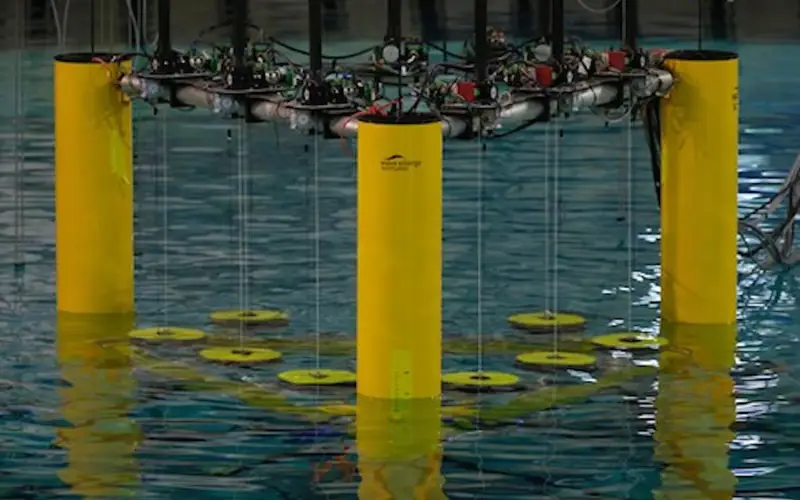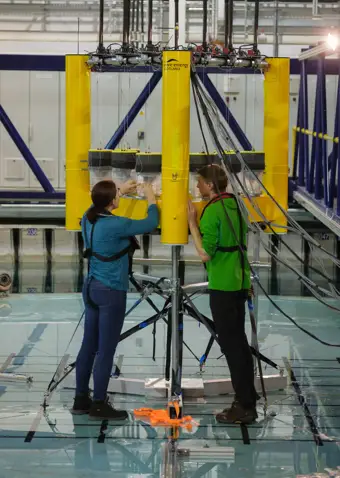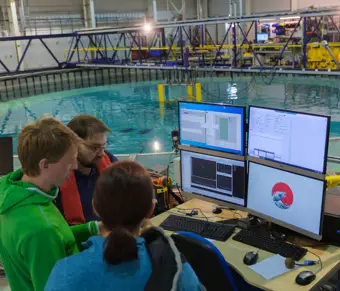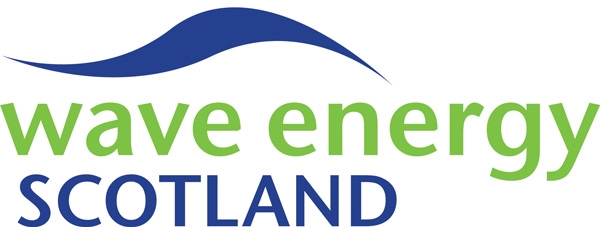
Platforms of Opportunity: Using Floating Wind To Inspire Wave Energy Arrays
By Matthew Holland & Niall McLean
As well as supporting current technology leaders here at Wave Energy Scotland (WES), we also continue to investigate what the future may bring for the wave energy sector. One of these future opportunities may come through synergies with the growing offshore wind sector.
You could think of it as though wind is the equivalent of our ‘older sibling’, and once wave energy technology is more mature we may be able to take advantage of both the learnings from the challenges that they’ve had to overcome and the infrastructure that has been put in place to support their growth. This theory was supported by a previous study on co-location of wind and wave carried out by Offshore Wind Consultants on behalf of WES, which found that levelised cost of energy reduction benefits to both wind and wave developers could be achieved through co-location.
Concurrently, WES had also been considering the challenge of scaling up wave energy devices. Given that wave energy converters (WECs) need to be designed to respond appropriately to the predominant wave conditions and to be structurally efficient, there are limitations to how big the individual WECs which are currently under development can get. This constraint on size leads to an associated cap on the total energy captured by each device.
However, if you could cluster multiple devices together, they could collectively capture a much larger amount of energy. We say “could”, because a fundamental principle of a wave device is that a good absorber is also a good wave generator. Placing many devices in close proximity will result in complex wave interactions, affecting the conditions experienced by each device and impacting the amount of wave energy available to be absorbed. The risk is that there may be destructive interference, where the energy captured by the system is reduced by these hydrodynamic interactions either between the devices themselves or between the devices and the host platform.
While there is a substantial body of published research on optimising annual energy production (AEP) through device spacing in typically targeted wave resources for large wave farms (>20 devices), there is far less research in the public domain about how the AEP is impacted when small groups of devices (<10 devices) are located close together in a cluster or are attached to a platform that is comparable in size to those being proposed for offshore wind applications.
Therefore, before pursuing any closely packed, clustered arrangements in detail, we first had to investigate the impact of adding devices in close proximity to one another on the power performance.
To do this, a collaborative project was initiated with FloWave and the University of Edinburgh. Using a baseline of a notional multi-wave absorber platform (MWAP), which used a typical floating wind platform design to host multiple WEC devices, this project has employed numerical and physical modelling of various layouts of both the MWAP system and of solo WECs without a platform to gain insight into how the AEP of these prospective arrangements could be impacted.
At this stage, it’s also important to clarify that our MWAPs are also assumed to be wave-only, with the technical risks associated with wind-only platforms and wave technologies that are still being addressed meaning that development of a fully hybrid wind and wave platform is unlikely to considered until a long time into the future.
The notional platform chosen as the basis of this study was motivated by floating wind platforms currently in development, assuming that any future MWAP would be inspired by their characteristics and could take advantage of any potential supply chain synergies that shared expertise and infrastructure could enable.
Point absorber-type WECs and their variants are the most likely candidate WECs for deployment on MWAPs. They utilise a single mode of motion and have relatively small excursions of the prime mover for power capture, characteristics that are both compliant with being mounted to a host structure. The WEC device used in our study was a simple version of a submerged pressure differential-type WEC, comparable to the AWS Waveswing that was developed through WES’s Novel Wave Energy Converter (NWEC) programme.
Prior studies into device interactions have suggested that behaviour between WEC devices should be consistent if the centres of the device are spaced a minimum distance of 2x diameters apart, so this spacing formed the basis of the baseline layouts considered in our investigations.
Physical model tests were undertaken in the tank at FloWave using a 9-WEC platform with various mooring arrangements. These tests enabled us to capture performance data and to review the impact that mooring stiffness may have on the power capture of the MWAP system. Alongside this, a set of numerical models were developed that would allow us to investigate a wider range of input conditions, control settings and mooring restraint options for a set of defined layouts. The input conditions were based on the proposed site for the Talisk Offshore Wind Farm, the models used either reactive and simple resistive control settings with the same control parameters applied to all WECs in the layout, and the layouts included widely spaced solo WECs, 3-WEC and 9-WEC platforms, and 9-solo WECs with equivalent spacing but no platform.
The outputs of the arrangements comparable to those tested in the tank could be compared, while the additional layouts provided insight into how different layouts could affect power capture.
The key outcome from all these investigations is that, for the specific layouts and control types tested using this un-optimised system, it appears that there is a performance degradation of <15% when comparing the energy captured of a cluster of 9x WECs on a single platform to 9x solo WECs that are assumed to not interact at all.
The energy output of the WEC arrays, with or without the platform, also appear to be insensitive to the direction of incoming waves, with a low level of variability of seen in device behaviour.
Since we have implemented a notional system that aims to better understand the influence of interaction effects on performance of an MWAP-type solution, there may be opportunities to improve the relative energy captured by a cluster of WEC devices if you were to develop the full design of a realistic MWAP system and its moorings. For example, improvements may be possible through co-design of the key system elements, or the implementation of advanced control options such as independent control of each WEC in the array, coordinated control that optimises the behaviour of each WEC based on the overall system (platform or array) response in a sea state, or wave-by-wave control.
Comparable performance between clusters of WEC devices and group of widely spaced solo WECs may not be sufficient though to balance out the impacts on capital expenditure and operational expenditure from using a conventional floating wind platform as a host structure. To better understand the potential design considerations and challenges for a wave-specific host platform which must be balanced against the performance impact, Wave Energy Scotland contracted Blackfish Engineering to investigate the design considerations for platform clustering arrangements.
This is obviously not the end of the need to investigate these types of cluster systems, as further refinements of the design will have an impact on the WEC hydrodynamic interactions and will need to continue to be modelled and tested. But the outputs of our first steps suggest that it may be possible for an optimised solution of a dense WEC cluster or WEC platform to offer comparable performance to more widely spaced, non-interacting, WEC arrays.
Our upcoming blogs will provide more background on the physical model testing and numerical modelling activities that we have undertaken through the MWAP project, before introducing the wider engineering challenges and considerations associated with clustering arrangements captured in the Blackfish work.



